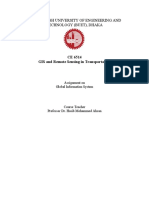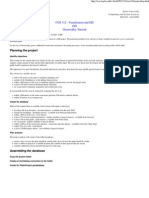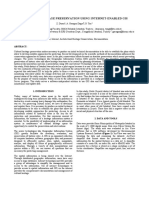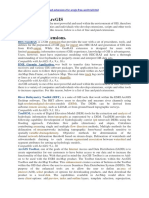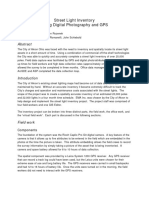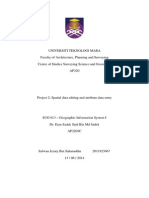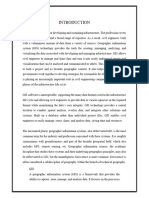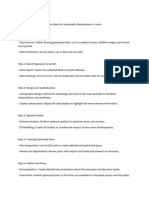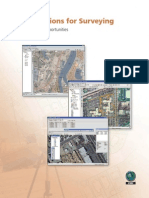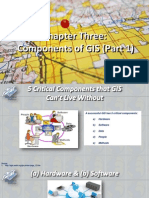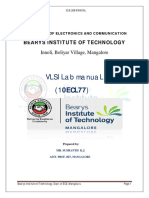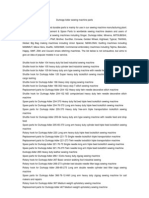0 ratings0% found this document useful (0 votes)
219 viewsM Mohsen Report
M Mohsen Report
Uploaded by
api-258809638Copyright:
© All Rights Reserved
Available Formats
Download as PDF, TXT or read online from Scribd
M Mohsen Report
M Mohsen Report
Uploaded by
api-2588096380 ratings0% found this document useful (0 votes)
219 views13 pagesOriginal Title
m mohsen report
Copyright
© © All Rights Reserved
Available Formats
PDF, TXT or read online from Scribd
Share this document
Did you find this document useful?
Is this content inappropriate?
Copyright:
© All Rights Reserved
Available Formats
Download as PDF, TXT or read online from Scribd
Download as pdf or txt
0 ratings0% found this document useful (0 votes)
219 views13 pagesM Mohsen Report
M Mohsen Report
Uploaded by
api-258809638Copyright:
© All Rights Reserved
Available Formats
Download as PDF, TXT or read online from Scribd
Download as pdf or txt
You are on page 1of 13
Construct A Geodatabase for An Area of
Carrazeda de Ansies" Municipality by ArcGIS
2013
MOHAMED MOHSEN NASR SABER BAKR
FACULTY OF ARTS PORTO UNIVERSITY
MASTERS IN GEOGRAPHICAL INFORMATION SYSTEMS AND SPATIAL PLANNING
Construct Geodatabase by ArcGIS
2013
1
Index
2
1- Introduction
3
2- Methodology
4
2-1 Data Collection
5
2-2 Unify Coordinate System
6
2-3 Create Geodatabase
7
2-4 Create Domains
8
2-5 Vectorization
9
2-6 Create Topology
10
2-7 Data Entry
11
2-8 Data Output
12
4- bibliography
Construct Geodatabase by ArcGIS
2013
2
1 Introduction:
The geodatabase is the common data storage and management
framework for ArcGIS. It combines "geo" (spatial data) with "database"
(data repository) to create a central data repository for spatial data
storage and management.
A collection of feature classes stored together so they can participate in
topological relationships with one another. All the feature classes in a
feature dataset must share the same spatial reference; that is, they must
have the same coordinate system and their features must fall within a
common geographic area. Feature classes with different geometry types
may be stored in a feature dataset. In ArcGIS, feature classes that
participate in a geometric network must be placed in a feature dataset.
By storing data within a geodatabase, we can take advantage of its data
management capabilities to leverage spatial information. And the
geodatabase to be complete not only by creating it but also input data of
the study area which consists of vectorization, data attributes entry and
topology. And the right and good data input the right output easily so
the most important step in any project is inputting data step.
Construct Geodatabase by ArcGIS
2013
3
Data Collection
Unify Coordinate System
Create Geodatabase
Create Domains
Vectorization
Create Topology
Data Entry
Data Output
2 Methodology:
Construct Geodatabase by ArcGIS
2013
4
2-1 Data Collection:
- There are a lot of sources for geographic data in the internet.
One of the most important sources is Google Maps. In this project
I used Google Maps to collect a data about landuses, services,
roads which was about names, locations and pictures of it.
Carrazeda Ansies Garden
Carrazeda Ansies Green Park
FireFighters Volunteer Center Financial Services Office
Municipal Cemetery of Carrazeda Ansies Ansies Professional School
Construct Geodatabase by ArcGIS
2013
5
- Another source for data which collected was Portuguese
Geographic Institute and Geofabrik web sites which provide free
geodata to download about Portugal.
- In addition the basic project data from the professor which was
satellite image and shape file for the study area limits.
2-2 Unify Coordinate System:
- After collecting all data, we have to define projection or make
Feature projection project for all of them to unify the coordinate
system to be able for showing together in the same layout
whenever we need.
- In this project I used Projection System Datum 73 Hayford Gauss
IPCC for all layers but at first I had to make a project to Hayford
Gauss IGeoE.
Construct Geodatabase by ArcGIS
2013
6
2-3 Create Geodatabase:
- Geodatabase used primarily to store, query, and manipulate
spatial data. Geodatabases store geometry, a spatial reference
system, attributes, and behavioral rules for data. Various types of
geographic datasets can be collected within a geodatabase,
including feature classes, attribute tables, raster datasets, network
datasets, topologies, and many others
- The main task in this project is creating personal geodatabase of
an area which has to contain feature datasets for all geodata
collected in a feature classes form (polygon, line, points)
depending on the data type. Roads should be lines, landuse
polygons, Geodesic points ..
Construct Geodatabase by ArcGIS
2013
7
2-4 Create Domains:
- In a geodatabase, a mechanism for enforcing data integrity.
Attribute domains define what values are allowed in a field in a
feature class or nonspatial attribute table. If the features or
nonspatial objects have been grouped into subtypes, different
attribute domains can be assigned to each of the subtype.
- In this project I did domains for the vectorization feature classes
(landuse Roads).
Construct Geodatabase by ArcGIS
2013
8
2-5 Vectorization:
- The conversion of raster data (an array of cell values) to vector
data (a series of points, lines, and polygons).
- By the feature classes of Vectorization Survey dataset I
vectorized all landuses, roads, water bodies which appear in the
satellite image inside the limits of the study area by using the
Editing Toolbar.
Construct Geodatabase by ArcGIS
2013
9
2-6 Create Topology:
- In geodatabases, the arrangement that constrains how point,
line, and polygon features share geometry. For example, street
centerlines and census blocks share geometry. Topology defines
and enforces data integrity rules (for example, there should be no
gaps between polygons). It supports sophisticated editing tools,
and allows feature construction from unstructured geometry (for
example, constructing polygons from line).
- I did in this project topology for the Dataset Vectorization
Survey and selected feature class landuse for participating
topology by rules:
A - Must Not Overlap
- Requires that the interior of polygons in the feature class not
overlap. The polygons can share edges or vertices. This rule is used
when an area cannot belong to two or more polygons.
B- Must Not Have Gaps
- This rule requires that there are no voids within a single polygon
or between adjacent polygons. All polygons must form a
continuous surface. An error will always exist on the perimeter of
the surface.
Construct Geodatabase by ArcGIS
2013
10
2-7 Data Entry:
- By selecting every object has been drawn in the map and entre
all its attributes data by writing data if there is no domain or select
the record which exists as a domain like landuse and roads feature
classes.
Construct Geodatabase by ArcGIS
2013
11
2-8 Data output:
A- Symbology:
The set of conventions, rules, or encoding systems that define
how geographic features are represented with symbols on a map.
A characteristic of a map feature may influence the size, color, and
shape of the symbol used.
B- Layout:
- Map design: The arrangement of elements on a map, possibly
including a title, legend, north arrow, scale bar, and geographic
data.
- A presentation document incorporating maps, charts, tables,
text, and images.
Construct Geodatabase by ArcGIS
2013
12
3- Bibliography:
http://www.igeo.pt -
http://download.geofabrik.de/europe.html -
https://maps.google.com -
http://support.esri.com/en -
You might also like
- Cogo ManualDocument18 pagesCogo ManualKyan PbNo ratings yet
- Berkovich - Waching Communism To FailDocument315 pagesBerkovich - Waching Communism To FailwojttegNo ratings yet
- Geographical Information System ProjectDocument15 pagesGeographical Information System ProjectMohd Fadhil MusbahNo ratings yet
- Introduction To GIS: Module ObjectivesDocument20 pagesIntroduction To GIS: Module ObjectivesNadira Nural AzhanNo ratings yet
- Intro To ArcGIS 9.3Document17 pagesIntro To ArcGIS 9.3Hasan SarptaşNo ratings yet
- Tribhuvan University: Institute of EngineeringDocument16 pagesTribhuvan University: Institute of Engineeringphoenix waibaNo ratings yet
- Gis Naib TehsildarDocument11 pagesGis Naib Tehsildarjamil ahmedNo ratings yet
- Assignment 5Document4 pagesAssignment 5msnavi65No ratings yet
- SUG613 GIS - Project ReportDocument10 pagesSUG613 GIS - Project ReportSafwan IzzatyNo ratings yet
- Bangladesh University of Engineering and Technology (Buet), DhakaDocument19 pagesBangladesh University of Engineering and Technology (Buet), DhakaRashedKhanNo ratings yet
- GIS Bloggers Intensive Courses 2024Document7 pagesGIS Bloggers Intensive Courses 2024elsayedali1ya2No ratings yet
- Gis Top 4 QuestionsDocument6 pagesGis Top 4 Questionsjashuvaj70No ratings yet
- AtulDocument29 pagesAtulAtul GuptaNo ratings yet
- ArcGIS TutorialDocument9 pagesArcGIS TutorialbebebrendaNo ratings yet
- A Sample Geodatabase Structure For Managing Archaeological DataDocument13 pagesA Sample Geodatabase Structure For Managing Archaeological DataMarko CekovićNo ratings yet
- Erdas: IMAGINE EssentialsDocument10 pagesErdas: IMAGINE EssentialsZakko NickNo ratings yet
- The Opengeo: Tcs PublicDocument20 pagesThe Opengeo: Tcs PublicSanjeet RathNo ratings yet
- Phase 1 - Frameing The Concept of What Is GIS - An IntroductionDocument10 pagesPhase 1 - Frameing The Concept of What Is GIS - An IntroductionBadru GbolahanNo ratings yet
- 3D Geo Modelling - ArcsceneDocument12 pages3D Geo Modelling - ArcsceneHaroonNo ratings yet
- Geographic Information Systems (GIS)Document4 pagesGeographic Information Systems (GIS)ankur_mandawatNo ratings yet
- Cultural Heritage Preservation Using Internet-Enabled GisDocument4 pagesCultural Heritage Preservation Using Internet-Enabled GisArch TheoNo ratings yet
- Fundamentals of Arcgis Desktop PathwayDocument28 pagesFundamentals of Arcgis Desktop PathwayhujabryNo ratings yet
- Amjad Ali Shah Gis CV 2021Document3 pagesAmjad Ali Shah Gis CV 2021arahman1986No ratings yet
- arcGIS Intro PDFDocument6 pagesarcGIS Intro PDFtilayeyidegNo ratings yet
- GIS TutorialDocument24 pagesGIS Tutorialmanohar manuNo ratings yet
- Lab 1Document6 pagesLab 1John BowersNo ratings yet
- Basic GISDocument61 pagesBasic GISsaven jayamannaNo ratings yet
- A Report ON Arc-Gis: Submitted To Prof - Gitakrishnan RamaduraiDocument5 pagesA Report ON Arc-Gis: Submitted To Prof - Gitakrishnan RamaduraiVishwaksen RajNo ratings yet
- Components of GISDocument33 pagesComponents of GISvotetorecieve 1No ratings yet
- Implementing A Gis and Applications: Unit VDocument14 pagesImplementing A Gis and Applications: Unit VShyam NaniNo ratings yet
- Geomatics AcademyDocument6 pagesGeomatics Academyeslamahmedmosa123No ratings yet
- ESRI ArcGIS Desktop AssociateDocument14 pagesESRI ArcGIS Desktop AssociateМусаев Карим100% (1)
- Advanced Geographic Information Systems: Module-3Document132 pagesAdvanced Geographic Information Systems: Module-3Bharath AshuNo ratings yet
- GIS Lab ManualDocument10 pagesGIS Lab Manualsatishkumarkolluru9809100% (2)
- Gis and ArcgisDocument2 pagesGis and ArcgisPaulo CagnanNo ratings yet
- GIS WEEK 5&6Document23 pagesGIS WEEK 5&6umarmaryammuhammad22No ratings yet
- Extensions For ArcGISDocument4 pagesExtensions For ArcGISaliNo ratings yet
- Basic Components of GIS and The Interrelationship Among ThemDocument5 pagesBasic Components of GIS and The Interrelationship Among ThemNaveen Neeharika100% (1)
- UNIT - 5 - Paper-IX - SEM-V - 2024-25 - EnglishDocument13 pagesUNIT - 5 - Paper-IX - SEM-V - 2024-25 - EnglishGaurav JhaNo ratings yet
- Components of GISDocument28 pagesComponents of GISpadmapriyaNo ratings yet
- Opengeo ArchitectureDocument15 pagesOpengeo ArchitectureArif SurahmanNo ratings yet
- Assignment 3Document9 pagesAssignment 3msnavi65No ratings yet
- Streetlight White PaperDocument5 pagesStreetlight White PaperSafae MashateNo ratings yet
- DefinitionsDocument3 pagesDefinitionsAlina ManduNo ratings yet
- The Application of Arcgis Cadastral Fabric Model For Cadastral Database ManagementDocument6 pagesThe Application of Arcgis Cadastral Fabric Model For Cadastral Database ManagementTudor BorsanNo ratings yet
- Data Storage and Eiditing in Gis: Maged Ba ZuhairDocument5 pagesData Storage and Eiditing in Gis: Maged Ba ZuhairAsad YousafNo ratings yet
- Sagar 1Document15 pagesSagar 1Abhilash MNo ratings yet
- CH 4 GISDocument7 pagesCH 4 GISmissaanchal146No ratings yet
- Gis App and Plannin of Gis DatabaseDocument21 pagesGis App and Plannin of Gis DatabaseAnkit R ShahNo ratings yet
- SUG613 GIS - Project 2 ReportDocument10 pagesSUG613 GIS - Project 2 ReportSafwan IzzatyNo ratings yet
- Bhagabati GroupDocument16 pagesBhagabati GroupAnandNo ratings yet
- Report GLS280Document54 pagesReport GLS280Muhammad AimanNo ratings yet
- Spatial Database1Document19 pagesSpatial Database1sunshineropanianagallardoNo ratings yet
- PROYECTO CARTOGRÁFIADocument2 pagesPROYECTO CARTOGRÁFIAStiven Chavez MelendezNo ratings yet
- Agatha's Digital Mapping AssignmentDocument7 pagesAgatha's Digital Mapping AssignmentUzoma FrancisNo ratings yet
- Map InfoDocument4 pagesMap InfoMaxim GhereaNo ratings yet
- Gis Sols For SurveyingDocument12 pagesGis Sols For SurveyingItalo NystuhNo ratings yet
- Geographical Information Systems (GIS) and Remote Sensing: ArtelmeDocument54 pagesGeographical Information Systems (GIS) and Remote Sensing: ArtelmeLis AlNo ratings yet
- SGC Chapt 3 Part I and IIDocument16 pagesSGC Chapt 3 Part I and IIapi-218737728No ratings yet
- Programming 1Document7 pagesProgramming 1api-258809638No ratings yet
- Mohamed Bakr CV enDocument9 pagesMohamed Bakr CV enapi-258809638No ratings yet
- M Mohsen Final ReportDocument9 pagesM Mohsen Final Reportapi-258809638No ratings yet
- Wind Power in PortugalDocument27 pagesWind Power in Portugalapi-258809638No ratings yet
- Barabtarlo - Nabokovs Reliquary PoemDocument8 pagesBarabtarlo - Nabokovs Reliquary PoemKebab TvrtkićNo ratings yet
- Vlsi Lab Manual (10ecl77) : Bearys Institute of TechnologyDocument96 pagesVlsi Lab Manual (10ecl77) : Bearys Institute of TechnologySUSHANTH K JNo ratings yet
- G196-08 (Reapproved 2016) PDFDocument6 pagesG196-08 (Reapproved 2016) PDFHadi HowaidaNo ratings yet
- Vacon NX Brake Resistor User ManualDocument38 pagesVacon NX Brake Resistor User Manualclaudir.calazansNo ratings yet
- Safety Data Sheet Sds/Msds Drabkin'S Solution (Diluent) MSDS CAS: 0000000000Document9 pagesSafety Data Sheet Sds/Msds Drabkin'S Solution (Diluent) MSDS CAS: 0000000000Christine Rodriguez-GuerreroNo ratings yet
- ISYS6300 Business Process Fundamental: Week 7 The Production CycleDocument39 pagesISYS6300 Business Process Fundamental: Week 7 The Production CycleEdwar ArmandesNo ratings yet
- Durkopp Adler Sewing Machine PartsDocument2 pagesDurkopp Adler Sewing Machine PartssewingtechnologyNo ratings yet
- Research Guidelines RevDocument6 pagesResearch Guidelines Revsmartworldcyber9No ratings yet
- Contracts - Law School ExamplesDocument42 pagesContracts - Law School ExamplesKatlyn Taylor MilliganNo ratings yet
- Evanston - Northwestern University Memorandum of Understanding Regarding Annual PaymentsDocument23 pagesEvanston - Northwestern University Memorandum of Understanding Regarding Annual PaymentsJonah MeadowsNo ratings yet
- Basic GSM/GPRS Training: An Introduction To The Global System For Mobile Communication (GSM) Sascha MeyerDocument67 pagesBasic GSM/GPRS Training: An Introduction To The Global System For Mobile Communication (GSM) Sascha MeyerbethorNo ratings yet
- Special Education ProgramDocument6 pagesSpecial Education Programapi-348366222No ratings yet
- Tutorial 2 - SolutionsDocument29 pagesTutorial 2 - SolutionsVeda Vyas PotnuruNo ratings yet
- A Study On Employee Stress Management in Pushpa Pipes Private Limited at MaduraiDocument107 pagesA Study On Employee Stress Management in Pushpa Pipes Private Limited at MaduraiAnonymous qRAAcePNo ratings yet
- Body Language How To Analyze People and Use Powerful Communication, Persuasion and Negotiation Skills To Influence People (Navarro, Philip Houston, Joe) (Z-Library)Document95 pagesBody Language How To Analyze People and Use Powerful Communication, Persuasion and Negotiation Skills To Influence People (Navarro, Philip Houston, Joe) (Z-Library)samucas02escolaNo ratings yet
- STRATEGIC COST MANAGEMENT - Intro To SCMDocument6 pagesSTRATEGIC COST MANAGEMENT - Intro To SCMVanna AsensiNo ratings yet
- Toward The Production of Safer ChemicalsDocument5 pagesToward The Production of Safer ChemicalsBramJanssen76No ratings yet
- Depreciation at Delta Air Lines and Singapore AirlinesDocument108 pagesDepreciation at Delta Air Lines and Singapore AirlinesViswanathan Gowtham Koduru100% (1)
- ARB RD176 ManualDocument40 pagesARB RD176 ManualalanschNo ratings yet
- Network Layer Protocols: Arp, Ipv4, Icmp, Ipv6, and Icmpv6: Review QuestionsDocument4 pagesNetwork Layer Protocols: Arp, Ipv4, Icmp, Ipv6, and Icmpv6: Review QuestionsRizqi FajrilNo ratings yet
- Ipseveranne - Amanda DollDocument11 pagesIpseveranne - Amanda DollAn Bn100% (2)
- PLC Mathematics Year 2Document5 pagesPLC Mathematics Year 2AndyKongNo ratings yet
- CH 4 - The Meaning of Interest RatesDocument46 pagesCH 4 - The Meaning of Interest RatesAysha KamalNo ratings yet
- Specification Sheet-Supporting StructureDocument9 pagesSpecification Sheet-Supporting StructureRakesh YadavNo ratings yet
- Adapting Your Words To Your Readers: Md. Al-AminDocument34 pagesAdapting Your Words To Your Readers: Md. Al-AminKarthikeyan MuttanNo ratings yet
- When Art Imitates Life-Burning of CinemasDocument3 pagesWhen Art Imitates Life-Burning of CinemasIrfan SayedNo ratings yet
- Template - Condition Audit PHE Checklist Rev.3Document5 pagesTemplate - Condition Audit PHE Checklist Rev.3Karen GoolcharanNo ratings yet
- Anderson I. - Chess Visualization Course Book 1 Part 1Document168 pagesAnderson I. - Chess Visualization Course Book 1 Part 1Willy Martinez100% (2)
- StellarRotation Jean LouisTassoul PDFDocument273 pagesStellarRotation Jean LouisTassoul PDFMoisésNo ratings yet











